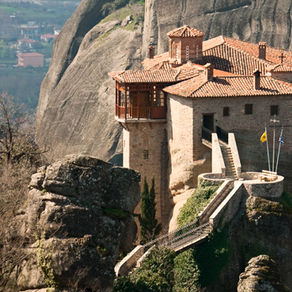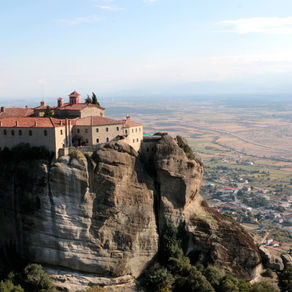Meteora
The Rocks of Faith
Authors
George & Panagiotis | The Shiny Greece Team (feat. ai)

The Incredible Rock Formations "Meteora" above Kastraki | Photo by: ID 336879501 © Monticelllo, Dreamstime.com
Meteora is one of the most awe-inspiring landscapes in Greece, a destination where the artistry of nature meets the profound spirituality of human endeavor. Towering rock pillars, seemingly sculpted by divine hands, rise dramatically from the plains of Thessaly near the town of Kalampaka. These colossal stone formations, nestled between the Antichasia and Koziakas mountains, evoke a sense of insignificance in the face of nature’s grandeur.
The word "Meteora" translates to "suspended in the air" in Greek - a fitting name for the monasteries that perch precariously atop these towering cliffs. The formation of the rocks dates back to the Paleogene period, not due to volcanic activity but as a result of intense tectonic movements and natural erosion. Around 1,000 AD, hermits and ascetics drawn by the area’s seclusion and spiritual energy began inhabiting the caves and hollows of Meteora. Seeking to draw nearer to the divine, they created a monastic community that grew in size and importance over the centuries.
By the 14th century, they began constructing monasteries atop the stone columns - structures that defy gravity and showcase human devotion and ingenuity.
At its peak, Meteora housed 24 monasteries, each a sanctuary for prayer, reflection, and monastic life. Today, only six remain active - four inhabited by monks and two by nuns - while the rest lie in silent ruin, bearing witness to the area's spiritual legacy. Recognizing its exceptional cultural and natural value, UNESCO designated Meteora as a World Heritage Site in 1989.

Ypapantis Monastery Meteora | Photo by: ID 348695382 © Apostolos Giontzis, Dreamstime.com
This majestic landscape has not only attracted pilgrims and tourists but also filmmakers and artists. It served as the backdrop for several notable films, including the James Bond classic For Your Eyes Only and local cinematic gems like The Illegals and Meteoro and Shadow. In 2014, Buzzfeed ranked Meteora among the 16 most beautiful places on Earth, further cementing its global appeal. Beyond the monasteries, the region offers a wealth of natural and cultural attractions - from the scientific marvel of Theopetra Cave to the picturesque Koziakas mountain range and the vibrant nearby city of Trikala. Whether you're a spiritual seeker, history enthusiast, climber, or nature lover, Meteora offers an experience unlike any other.
History
The history of Meteora is as captivating as its dramatic cliffs. Human presence in the area dates back nearly 50,000 years, with evidence found in the Theopetra Cave - a remarkable archaeological site that showcases the transition from Neanderthals to Homo sapiens. A stone wall built around 25,000 BC at the cave’s entrance, likely used to block icy winds during the Ice Age, is considered one of the oldest man-made structures ever discovered.
The spiritual legacy of Meteora began around the 9th century AD, when ascetic monks seeking solitude and divine connection began settling in the natural hollows and caves of the rocks. Living in isolation, they gradually formed a spiritual community dedicated to prayer and contemplation. By the 14th century, a more organized monastic life took root when Athanasios the Meteorite - originally from Mount Athos - founded the Great Meteoron Monastery in 1344. His vision inspired the construction of more monasteries in the following decades.

Varlaam Monastery Meteora | Photo by: ID 348693917 © Apostolos Giontzis, Dreamstime.com
The monasteries were not only religious sanctuaries but also safe havens during turbulent times. As the Ottoman Empire expanded in the 15th century, hermit monks sought protection in these inaccessible heights. Between the 15th and 16th centuries, more than 20 monasteries were built atop the rocky pillars, their architecture adapting ingeniously to the geological features of the cliffs.
For centuries, access was possible only via retractable ladders or nets pulled up by windlasses - a testament to the monks' determination to remain undisturbed by the outside world. By the 20th century, many of these monasteries fell into disrepair or were abandoned, while others began carving stone steps into the cliffs to allow safer access for visitors. Meteora's cultural and historical significance has been acknowledged globally. In addition to its status as a UNESCO World Heritage Site, it has been a place of inspiration for religious pilgrims, scholars, and artists.
The area is also the birthplace of significant figures in Greek history and culture, such as Saint Athanasios the Meteorite, legendary rebetiko musicians Vasilis Tsitsanis and Kostas Virvos, renowned singers like Dimitris Mitropanos and Giorgos Margaritis, and athletes such as Christos Papanikolaou and Sofia Sakorafa. From its prehistoric roots to its spiritual zenith, Meteora stands as a powerful symbol of endurance, faith, and human achievement.
Weather & Climate
Meteora experiences a typical continental climate, marked by cold winters and hot summers. The region’s location at the foothills of the Pindos mountain range means temperatures can vary widely throughout the year. Winters (December to February) are usually cold, with occasional snowfall that adds a mystical touch to the landscape. Spring and autumn are the most pleasant times to visit, offering mild temperatures and fewer crowds. Summers (June to August) can get quite hot during the day, but the elevated terrain offers some natural relief, especially in the early mornings and evenings. Due to its elevation and topography, sudden weather changes are not uncommon, so it’s wise to come prepared for a variety of conditions.

Valley of Meteora | Photo by: ID 35704791 © Evgeniy Fesenko, Dreamstime.com
Points of Interest
While the monasteries are undoubtedly the crown jewel of Meteora, the surrounding region offers a diverse range of attractions that enrich any visit. Chief among these is the Theopetra Cave, a site of exceptional archaeological importance. Located above the village of Theopetra at the base of the Chasia mountain range, this 500-square-meter cave reveals the deep prehistoric roots of human habitation in the area. Inside, scientists have discovered remains that document the shift from Neanderthal life to early farming societies, making it a unique site in world history. The nearby museum further explains the cave's significance with fascinating exhibits.

St. Nicholas Anapafsas Meteora | Photo by: ID 346536200 © Mikolaj64, Dreamstime.com
In the town of Kalampaka, the Byzantine Church of the Dormition of the Virgin (Kimisis tis Theotokou) stands as a monument to centuries of Christian worship. Dating back to the 10th century, it features a rare marble pulpit and remnants of early Christian frescoes. The town itself is worth exploring for its quaint streets, local shops, and welcoming atmosphere. Another must-see site is the Natural History and Mushroom Museum of Meteora, which offers an unusual but educational perspective on the local ecosystem. For nature lovers and hikers, the surrounding mountains - especially Koziakas and the Aspropotamos region - offer scenic trails through dense forests, traditional villages, and panoramic viewpoints over the Meteora formations.
Cultural life in Kalampaka and the nearby village of Kastraki also includes traditional festivals, folk music events, and markets where local crafts and delicacies are showcased. The area is also a hotspot for outdoor enthusiasts, particularly rock climbers and rappellers. However, due to the religious nature of the monasteries and the sanctity of the rocks, tensions sometimes arise between climbers and the monastic community, prompting ongoing discussions about respectful tourism practices.
Visit | Taste | Learn
Cuisine & Restaurants
The region surrounding Meteora is not only rich in history and spiritual depth but also deeply satisfying to the palate. Anchored in the fertile plains of Thessaly, the local cuisine is a celebration of agricultural abundance and culinary tradition. Visitors will find a variety of dishes that reflect the rustic, hearty, and authentic flavors of the Greek mainland, often enhanced by the monastic simplicity and purity that characterizes life in the monasteries themselves.
Traditional Thessalian cuisine is known for its generous use of local meats - especially lamb, goat, and pork - alongside seasonal vegetables, legumes, handmade pasta, and savory pies known as pites. You’ll often encounter specialties like spetsofai (sausage with peppers in a rich tomato sauce), kreatopita (meat pie), and hilopites (square-cut egg pasta served with cheese or in meat-based sauces). The influence of the monasteries is also evident in the presence of meatless dishes, especially during fasting periods, where lentils, chickpeas, wild greens, and pulses become the foundation of flavorful, wholesome meals.
A culinary highlight of the region is the local cheese production. Look out for galotyri, a creamy and tangy fresh cheese that pairs beautifully with bread or as a topping for roasted vegetables. Yogurt, often homemade, and thickly drizzled with honey and walnuts, is another must-try. Local wines and tsipouro - a strong, grape-based spirit traditionally served with small plates of food - are staples in every taverna and perfect for toasting your Meteora adventures.

Meteora Vineyards | Photo by: ID 175863129 © Eileen Tan, Dreamstime.com
As for dining venues, the town of Kalambaka and the nearby village of Kastraki host a number of welcoming restaurants that serve both locals and travelers. One standout is Meteoron Panorama, which lives up to its name with stunning views of the rock formations and a menu that blends classic Greek cuisine with modern presentation. For more traditional fare, Taverna Gardenia in Kastraki offers home-style dishes in a cozy, family-run environment that many travelers praise for its authenticity and generous portions.
Another excellent choice is Valia Calda, an elegant restaurant in Kalambaka that focuses on local ingredients and carefully curated wines from the broader Thessalian region. For vegetarians or those interested in lighter meals, Fortounis Tsipouradiko in Kalampaka offers a delightful range of meze plates that accompany tsipouro and ouzo, drawing inspiration from both mainland and island traditions. Don’t leave the area without trying a sweet treat such as galaktoboureko (semolina custard in syrupy phyllo) or the honey-soaked walnut cake known as karidopita.
In Meteora, food is not just sustenance - it is a window into the region’s culture, history, and values. Whether you’re dining in a modest village taverna or enjoying a panoramic meal under the shadows of the towering rocks, each bite connects you to a way of life that has remained proudly rooted in tradition.
Nightlife
While Meteora is best known for its tranquil monasteries and spiritual energy, that doesn't mean the area lacks life after sunset. The region offers a calm, yet enjoyable nightlife scene that aligns with the overall serene character of the destination. Visitors seeking all-night clubbing and beach parties won’t find that vibe here, but those who appreciate quiet evenings with good company, local spirits, and live music will find themselves right at home.
The town of Kalambaka, the main urban center beneath the towering Meteora rocks, is where most of the nightlife is concentrated. Here, the nightlife atmosphere is more about connection than chaos - places where locals mingle with travelers over a glass of wine, a chilled beer, or a shot of tsipouro. The evenings tend to begin with a leisurely dinner at a traditional taverna and then continue at a café-bar or wine bar where ambient music and a laid-back setting create the perfect end to a day of exploring.
One of the most popular evening spots is Pub 38, a cozy, tastefully decorated bar with a wide selection of whiskies, cocktails, and local spirits. Its warm atmosphere and rock-jazz soundtrack attract a mix of locals and tourists looking for quality drinks and good conversation. Another go-to place is Aerino, a stylish café-bar with a lovely outdoor seating area offering a direct view of the illuminated Meteora cliffs - a magical sight that leaves a lasting impression.

Kalambaka View from Meteora | Photo by: ID 342408531 © Antoniospapageorgiou1985, Dreamstime.com
In the nearby village of Kastraki, nightlife is even more low-key but equally rewarding. Most establishments close earlier, but the beauty of a quiet drink under the stars, with the silhouettes of Meteora’s towering rocks looming in the dark, offers a sense of intimacy and awe that’s hard to replicate elsewhere. Nightlife in Meteora may not be wild, but it is soulful. It invites you to slow down, savor the moment, and enjoy simple pleasures - good drinks, meaningful conversation, and the quiet magic of the rocks glowing in the moonlight.
Hotels
Accommodation in the Meteora region blends comfort, tradition, and breathtaking views, offering options for every type of traveler - from spiritual seekers and hikers to history lovers and romantic couples. Whether you prefer a boutique guesthouse nestled in a traditional village or a full-service hotel with panoramic views of the iconic rock formations, Meteora’s hospitality sector has evolved to offer high-quality experiences while remaining deeply connected to its cultural and natural heritage.
One of the most prestigious places to stay is the Divani Meteora Hotel, located in Kalambaka. This elegant hotel combines luxury with unbeatable views of the towering rocks. Its spacious rooms, modern amenities, and wellness facilities - including an outdoor pool and spa - make it ideal for travelers looking for relaxation after long days of exploration. The on-site restaurant offers traditional Greek and Mediterranean cuisine, and the hotel’s large windows frame Meteora’s cliffs in every direction.
A similar high-comfort experience is found at the Grand Meteora Hotel, located on the edge of the charming village of Kastraki. Built in the style of a traditional stone mansion, this hotel is known for its rustic design with modern touches. The rooms are tastefully decorated with warm colors and local details, while the panoramic dining area and comfortable lounge make it a favorite for those who want to enjoy the view even while indoors. Its peaceful location away from the main road ensures a restful atmosphere.

Courtyard of Great Meteoron Monastery | Photo by: ID 131660575 © Larysa Uhryn, Dreamstime.com
For travelers seeking a more personal and authentic feel, Hotel Kastraki is a well-known family-run establishment offering clean, cozy rooms and warm hospitality. Nestled right in the heart of the village, it provides a convenient base for visiting the monasteries while retaining the ambiance of a traditional Greek mountain guesthouse.
Similarly, Doupiani House Hotel, another gem in Kastraki, is praised for its beautifully maintained garden, local architecture, and rooms with private balconies that open up to awe-inspiring rock views. If you're traveling on a tighter budget but still wish to experience Meteora’s charm, Hotel Rex in Kalambaka offers simple but comfortable accommodation, friendly service, and a great location close to restaurants, shops, and the main monastery road.
For those wanting something even more immersive and unique, the The Storyteller Boutique House is a standout experience. Located in a restored stone house, it offers visitors a boutique-style stay filled with handmade furniture, local art, and storytelling evenings that connect guests with Meteora’s deep history and folklore. No matter where you stay in Meteora, the experience is shaped as much by the warm hospitality of the locals as by the natural beauty and spiritual ambiance of the rocks. The region’s accommodation choices invite you not just to rest, but to feel part of a timeless, awe-inspiring landscape.
Getting There
Reaching Meteora is relatively easy, with several options available depending on your starting point and travel preferences. The most common base for visiting Meteora is the town of Kalambaka, which lies just beneath the towering rock formations. If you’re traveling from Athens, you can take a direct train from Athens Central Railway Station (Larissa Station) to Kalambaka. The journey takes around 4 to 5 hours, and the train ride offers scenic views of the Greek countryside. Alternatively, you can drive from Athens, a journey of approximately 350 kilometers, which takes about 4 hours via the national highway through Lamia and Trikala.
From Thessaloniki, the drive is shorter - about 230 kilometers and 2.5 to 3 hours. Train services are also available but usually involve a transfer at Larissa. There are no direct flights to Meteora, as the region doesn’t have a nearby airport. However, you can fly into either Athens International Airport or Thessaloniki Airport and then continue by train, bus, or rental car. For those who prefer organized tours, many travel agencies offer day trips or overnight excursions to Meteora from Athens or Thessaloniki, which can be a convenient choice if you're short on time and want a guided experience.

Holy Trinity Monastery | Photo by: ID 164463580 © Vasilis Ververidis, Dreamstime.com
Meteora in Greece
Closing
Meteora is not just a place you visit - it’s a place you feel. The surreal rock pillars that rise toward the heavens, crowned with centuries-old monasteries, create a setting that is as emotionally stirring as it is visually majestic. Whether you're a lover of nature, history, spirituality, or simply breathtaking beauty, Meteora will touch something deep within you. This UNESCO World Heritage Site offers more than just postcard-perfect landscapes. It’s a window into the resilience of faith, the power of nature, and the timelessness of human endeavor. From hiking among the stone giants to standing in silent awe within ancient chapels, every experience here resonates with meaning.

Meteora | Photo by: ID 17428875 © Alexander Tolstykh, Dreamstime.com
And when the day winds down, and the sun casts golden shadows across the cliffs, Meteora takes on an even more mystical aura. It's a destination where moments turn into memories and where the soul can find both wonder and peace. Whether you're planning a cultural pilgrimage, a hiking expedition, or a peaceful retreat, Meteora promises a journey that will remain etched in your heart long after your return.






























